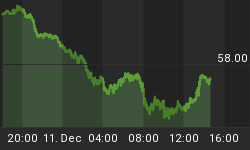Structural investments are perhaps the most powerful. Gold has, for example, been in a structural bull market for more than a decade. Those political and economic trends that have propelled Gold from $250 were simply a "carnival" ride that had only one way to go, up. The structural deficits of the U.S., which stem from an intellectual deficit in government, meant that Gold had could only go up. All one had to do was identify the structural bull, and remain seated for the entire ride.
Agri-Food investments are shaping up as another structural investment theme. The Chinese economy has expanded in amazing fashion for more years than any expected. Naysayers have been plentiful over time, and wrong repeatedly. More people have been lifted out of poverty in China in the past decade than in any period of history. That growth will continue in meaningful fashion for another decade. As that growth continues about 15 million people will move into the middle class each year. As they do, they change their preferences for Agri-Foods. The question has often been in the past 100 years about how China will feed itself. With the shifting economic and income tides in China, the question changes form. How will the rest of the world afford to eat?

Source: "Urban growth in China: Challenges and prospects."
by K.C. Seto, Stanford University, Undated.
Through time, measuring the prosperity or poverty, of a nation has been fairly simple. The percentage of the population living in an urban setting has been a measure of prosperity. In contrast, percentage of the population in the agricultural sector is a measure of prosperity. For example, in the U.S. and other Western nations less than 5% of the population are involved in the production of Agri-Food. Remainder of the population earns an income sufficient to buy their needed Agri-Foods.
As the first graph shows, about 40% of China's population lives in urban centers. That level of urbanization is about that of the U.S. in 1900. As more of the population of a nation shifts from the agricultural setting to living in urban centers, the impact on productivity, economic activity, and incomes is dramatic. Almost any job these new urban workers take dramatically increases that individual's contribution to economic growth. That worker's income also takes a dramatic jump upwards. And as that happens a multiplier effect is felt throughout the economy. This shift to an urban population is a structural change in the Chinese economy. That shift translates into a structural shift in the global Agri-Food system. The bounty of Agri-Food in the 1960s in now no more than a history lesson. The next decade will be one of increasing global shortages of Agri-Food unlike anything seen in modern times.
Some today talk of a slow down in the growth rate of the Chinese economy due to the Obama Depression in the U.S. Yes, but their growth rate is still positive. That achievement is something the economic advisors in the Western nations have not been able to produce. And go back to that level of urbanization in the Chinese population, which compares to that of the U.S. in 1900. Imagine the wealth one would have amassed by buying the U.S. stock market in that year. And today the outlook for Chinese manufacturers is somewhat better. The $800+ billion spending in the Obama Pork Plan will benefit Chinese exporters to a large extent as that money is spent, much of it on goods imported from China.

The second chart this week is the percentage price move from the lows for a group of important Agri-Food stocks. The average increase, as indicated by the green squares, has been slightly more than 60%. That compares to about 9% for the S&P 500 and 24% for oil. While these results do not guarantee any particular future returns, they are encouraging.
Agr-Food stocks, like some other groups, are acting as if their bottom has been found. Markets may appear on charts to form "V" bottoms, but that is rarely the case. Individual groups with both good future fundamentals and an over sold condition bottom and begin to move first. While the business media continues to dwell on bank stocks of dubious merit and little interest, some groups of stocks are already in a new, or their own, cycle.
Agri-Food seems to be a timely structural investment. With more than 2 billion people in China and India striving for a better life, consumption of Agri-Foods will continue to move up the value chain. Why spend time dwelling on those stocks that may or may not recover under the dubious economic policies of the government of the U.S. and other nations? Perhaps the time has arrived to reposition your portfolio to the structural impact of China and India on Agri-Food demand. Is your portfolio ready for the future of Agri-Food, or is it still mired in the despair of the Obama Depression?
AGRI-FOOD THOUGHTS is from Ned W. Schmidt,CFA,CEBS, publisher of The Agri-Food Value View, a monthly exploration of the Agri-Food grand cycle being created by China, India, and Eco-energy. To receive the most recent issue of this publication, use this link: http://home.att.net/~nwschmidt/Order_AgriValueRECENT.html.

















